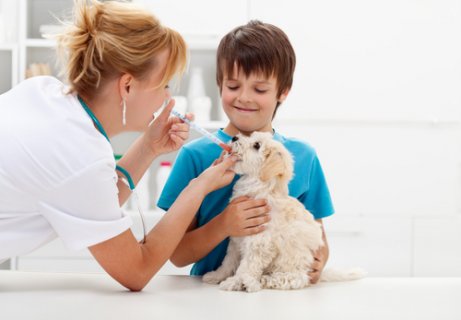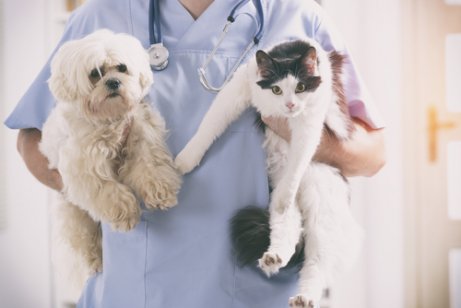Is it Good to Give Antibiotics to Your Pet?


Written and verified by the lawyer Francisco María García
Antibiotics are drugs that are widely used to treat diseases caused by bacteria. There are many types of antibiotics that can be used to control and fight different infections. Next, we’ll take a look at whether it’s good to give antibiotics to your pet. We’ll also explain the precautions that you should take with this kind of drug.
How do antibiotics work in the body?
Medications known as antibiotics are drugs that have a therapeutic effect due to the chemical interactions they generate in the patient’s organism.
As we mentioned, antibiotics are developed to treat bacterial infections. The chemical action of the drugs works to control the reproduction of bacteria that trigger the illness, or eliminate them completely.
Therefore, these drugs aren’t effective in combating diseases caused by other microorganisms, such as viruses or fungi.
Selective antibiotics vs. broad-spectrum antibiotics
The wide variety of existing antibiotics are usually classified into two large groups. These groups depend on the action in the body: selective antibiotics and broad-spectrum antibiotics.
- Selective antibiotics: These only act against certain bacteria. Therefore, the action is selective and is usually only effective in treating diseases caused by specific types of bacteria.
- Broad-spectrum antibiotics: These drugs act on a wide variety of bacteria. Their action works on a broad spectrum. This is why these drugs can be used to treat diseases that may be associated with more than one type of bacteria.

If you take a look at the packaging of an antibiotic drug, you can identify the main drug that acts on the bacteria. However, other chemical compounds that enhance the antibiotic action of the drugs are frequently added.
One example is clavulanic acid, which usually accompanies amoxicillin in many antibiotics on the market. Although it isn’t an antibiotic, it’s a chemical compound that enhances the action of amoxicillin, and improves treatment.
When do you need to give antibiotics to your pet?
Based on the information we’ve given you already, it makes sense that your pet may need antibiotics if he or she has an infectious disease caused by bacteria. However, before giving any antibiotics, you need a confirmed diagnosis that the disease is bacterial.
Frequently, people confuse the symptoms of a viral infection with a bacterial one. Because of this, it’s essential to go to the vet before giving antibiotics to your pet.
In addition, each animal is a unique being with a unique organism. This means that there is no one effective treatment that will work for all animals. Only a trained professional can verify your pet’s symptoms and, after confirming a diagnosis, determine an appropriate treatment for their specific needs.
Also, veterinarians often give antibiotics after surgical interventions. This prevents any skin lesions or scars from becoming infected during recovery.

Likewise, sometimes you may need to give antibiotics to your pet in the case of infestations of ticks, fleas, or mites. When you get rid of all of these ectoparasites, you’ll also need to prevent small lesions on the skin from becoming infected while they heal.
Why you should never self-medicate your dog
Unfortunately, some owners give antibiotics to their pets without the prior guidance of a veterinarian. However, self-medication is very dangerous and not recommended for people nor for pets.
There are some antibiotic drugs that are used to treat both people and animals. However, not all medicines for humans can be ingested by pets, and vice versa.
In addition, a veterinarian should always determine the doses and frequency of the medication. For example, a vet will consider the weight of the animal and its general health. This information allows vets to determine an effective and safe treatment plan.
Giving too much or the wrong type of antibiotics to your pet can lead to several unwanted side effects. These can range from vomiting and diarrhea, to intoxication. Here are some of the possible risks of self-medicating your pet.
Tips for safe treatment using antibiotics
- Only give antibiotics to your pet with the guidance of a veterinarian.
- Provide a comfortable, safe, and positive environment for your pet to help favor recovery.
- Consult a veterinarian about the use of probiotics to prevent an imbalance of your pet’s intestinal flora while taking antibiotics.
- Offer adequate preventative medicine to your animals throughout their lives. Take your pets to the veterinarian every six months. Also, always keep their vaccines and antiparasitics up to date.
All cited sources were thoroughly reviewed by our team to ensure their quality, reliability, currency, and validity. The bibliography of this article was considered reliable and of academic or scientific accuracy.
- Unterer, S., Strohmeyer, K., Kruse, B. D., Sauter-Louis, C., & Hartmann, K. (2011). Treatment of Aseptic Dogs with Hemorrhagic Gastroenteritis with Amoxicillin/Clavulanic Acid: A Prospective Blinded Study. Journal of Veterinary Internal Medicine. https://doi.org/10.1111/j.1939-1676.2011.00765.x
-
Dear, J. D. (2014). Bacterial pneumonia in dogs and cats. Veterinary Clinics of North America – Small Animal Practice. https://doi.org/10.1016/j.cvsm.2013.09.003
This text is provided for informational purposes only and does not replace consultation with a professional. If in doubt, consult your specialist.